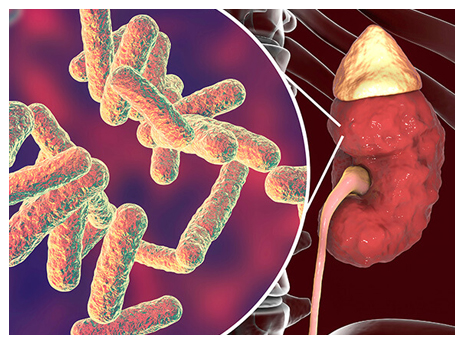

HAEMOLYTIC URAEMIC SYNDROME
Haemolytic uraemic syndrome (HUS) is characterised by thrombotic microangiopathy that causes damage to endothelial cells of the microcirculation. This is accompanied by swelling of the endothelial cells, increased platelet adherence and intravascular thrombosis. There is a marked reduction in the platelet count and anaemia, with features of intravascular haemolysis , such as a raised unconjugated bilirubin level, raised levels of LDH and decreased circulating levels of haptoglobin. A reticulocytosis is often seen.
CAUSES
The most common cause of HUS — particularly in children under the age of 5 — is infection with certain strains of E. coli bacteria. E. coli refers to a group of bacteria normally found in the intestines of healthy humans and animals. Most of the hundreds of types of E. coli are normal and harmless. But some strains of E. coli cause diarrhea.
SYMPTOMS
The signs and symptoms of HUS may vary, depending on the cause. Most cases of HUS are caused by infection with certain strains of E. coli bacteria, which first affect the digestive tract. The initial signs and symptoms of this form of HUS may include:
All forms of HUS — no matter the cause — damage the blood vessels. This damage causes red blood cells to break down (anemia), blood clots to form in the blood vessels and kidney damage.
SIGNS AND SYMPTOMS OF THESE CHANGES INCLUDE:
COMPLICATIONS
HUS can cause life-threatening complications, including:
HOMOEOPATHIC TREATMENT:
Merc cor: --Bruised sensation; cecal region and transverse colon painful. Bloated; very painful to least touch. Dysentery; tenesmus, not relieved by stool; incessant. Stool hot, bloody, slimy, offensive, with cutting pains and shreds of mucous membrane. Fever: Chilly from slightest exposure. Profuse perspiration; surface cold. Incessant, green, bilious vomiting. Epigastrium very sensitive.
Capsicum annum: Vomiting, sinking at pit of stomach. Much thirst; but drinking causes shuddering. -Bloody mucus, with burning and tenesmus; drawing pain in back after stool. Thirsty after stool, with shivering. Fever- Coldness, with ill-humor. Shivering after drinking. Chill begins in back; better, heat. Must have something hot to back. Thirst before chill.
Cantharis: -Shivering with burning. Dysentery; mucous stools, like scrapings of intestines. Bloody, with burning and tenesmus and shuddering after stool. Fever. Cold hands and feet, cold sweat. Soles burn. Chill, as if water were poured over him. . Vomiting of blood-streaked membrane and violent retching.
Psorinum: The therapeutic field of this remedy is found in so-called psoric manifestations. Psorinum is a cold medicine; wants the head kept warm, wants warm clothing even in summer. Extreme sensitiveness to cold. Debility, independent of any organic disease, especially the weakness remaining after acute disease. Lack of reaction, i.e, phagocytes defective; when well-chosen remedies fail to act. Scrofulous patients stool with Mucous, bloody, excessively fetid, dark fluid. Fever. Profuse, offensive perspiration; night-sweats
Rhus tox: -Violent pains, relieved by lying on abdomen. Swelling of inguinal glands. Pain in region of ascending colon. Colic, compelling to walk bent. Excessive distention after eating. Rumbling of flatus on first rising, but disappears with continued motion. Diarrheoa of blood, slime, and reddish mucus. Intermittent; chill, with dry cough and restlessness. Chilly, as if cold water were poured over him, followed by heat and inclination to stretch the limbs.